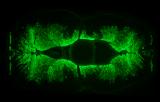 |
| THAR SHE GLOWS |
Ryoko Ando and Atsushi Miyawaki
I started with this picture by by Dr. Ando and Dr. Miyawaki to get you curious. What is this? In some ways it looks like a beetle to me--those kind that have brown colored stripes on their body and show up when you're playing in the dirt. Of course, it's not. Rather, pictured is a transverse section of a muscle in a fresh water eel with a activated protein that is glowing green.
Let me explain. In the article, "An eel's glow could illuminate liver disease," Rachel Ehrenberg describes the discovery of the scientists working for the RIKEN research institute in Japan. They were trying to understand the mechanism that turned on the protein in the eel and it's importance.
Let's switch gears for a minute. When hemoglobin in human red blood cells breaks down it produces bilirubin. Perhaps you've had a blood test done where this was measured and was reported to you along with your cholesterol, triglycerides, and potassium levels. What you may not have understood is that bilirubin levels indicate liver function. Why? It's part of the liver's job to keep those levels in normal ranges.
What scientists at the RIKEN research institute discovered was bilirubin had the ability to turn on the protein causing the eel to glow. While the application to human health is still a ways off, it's not hard to imagine a use for this protein to indicate an increase of bilirubin in a blood sample.
Before you click on the link to the article to understand more about this discovery and perhaps even read the scholarly article linked to the bottom of the webpage, I want to focus your attention on the cross over from fundamental questions (what turns on the protein) to applied science (liver functioning). For this to take place, scientists from different disciplines collaborate.
One more thing before you go, in looking for today's Sci-light, I stumbled across an NIH sponsored site called, "Team Science Toolkit." The opening paragraph of What is Team Science states, "Team science is a collaborative effort to address a scientific challenge
that leverages the strengths and expertise of professionals trained in
different fields. Although traditional single-investigator driven
approaches are ideal for many scientific endeavors, coordinated teams of
investigators with diverse skills and knowledge may be especially
helpful for studies of complex social problems with multiple causes."
Learning across disciplines and working collaboratively is the path of many scientists. Don't you want to be a part of the team?
No comments:
Post a Comment